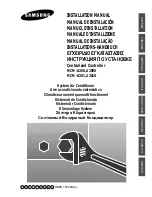
The unit is controlled by a conventional four wire heating/cool-
ing thermostat common to this class of equipment.
HEATING
On a call to heat, the room thermostat contacts close signaling
the control module. After the thermostat activation period of 3
seconds, the microprocessor runs its self-check routine verify-
ing normal condition of all inputs/outputs (I/O).
The control module energizes the flue inducer motor and enters
into pre-purge period of 15 seconds.
Following the pre-purge period the igniter is energized and the
igniter warm-up period begins.
In the igniter warm-up period the igniter is activated for 3
seconds, and remains energized for 7 seconds.
After completion of the warm-up time, flame failure response
time of more than 0.5 seconds and less than or equal to 0.8
seconds is changed and set at 2.0 seconds, the gas valve is
energized and the trial for ignition period begins.
During the trial for ignition period, the gas valve is activated for
3 seconds after the igniter activation and remains open for 5
seconds.
The gas valve is de-energized (if the flame is not sensed).
If there is a malfunction, the diagnostic LED will flash an error
until the number of flashes are over. It then waits for 2 seconds
until starting the flash sequence over. The indicator shall
provide the following flash codes:
(A) OFF - Normal operation.
(B) ON - Board failure.
(C) 1 flash - Ignition attempts or recycles.
(D) 2 flashes - Compressor low pressure switch open.
(E) 3 flashes - Compressor high pressure switch open.
(F) 4 flashes - Flue inducer centrifugal switch open (fault) or
closed (fault).
(G) 5 flashes - Flame rollout switch open.
(H) 6 flashes - Furnace high limit switch open.
(I)
7 flashes - (optional) - Heating mode 1 hour waiting period
for auto reset from flame failure lockout.
NOTE: If the flame is neither sensed nor established (at first
attempt), the control will attempt 11 more trials before
entering into a lockout.
If the flame is sensed, the blower on delay period begins.
The flame failure response is reset between more than 0.5
seconds and less than or equal to 0.8 seconds, 10 seconds
after initial flame sense.
If the flame is established, after the completion of on delay time
(30 seconds, including 10 seconds for flame establishment
time), the indoor air blower motor is energized at the heat
speed.
NOTE: If the flame is established in any of the 12 attempts and
flame failure time is set and then the proof the flame is
lost, the control will recycle to re-attempt for a total of
11 retrials beginning from pre-purge (including) before
entering into lockout. Anytime the flame is established,
the retry counter is zeroed and the control enters
normal operating loop where all input/outputs are con-
tinuously checked.
When the thermostat is satisfied (contacts open) thermostat
de-activations period starts.
After the completion of the thermostat de-activation time of 3
seconds the gas valve and inducer motor are de-energized, the
indoor air blower 45 second delay off period starts and the proof
of the flame is lost.
COOLING
On a call for cool, the thermostat contact close signaling the
control module. After the thermostat activation period of 3
seconds, the microprocessor runs its self-check routine verify-
ing normal condition of all inputs/outputs (I/O).
The control energized the compressor indoor blower contactor.
After the control has entered into a normal operating loop, all
the input/outputs are continuously checked for compliance with
all other sections.
When the thermostat is satisfied the compressor contactor is
de-energized and the blower delay off period starts.
After the delay to blower off timing (45 seconds), the indoor air
blower relay is de-energized.
SEQUENCE OF OPERATION
530.44-N5Y
8
Unitary Products Group






























